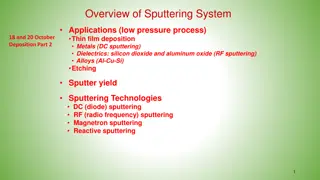Chemical Deposition Techniques in Solid State Physics
Chemical deposition is a fabrication technique using different chemicals for reactions, allowing coatings to form successfully. Techniques include spray pyrolysis, electrochemical deposition, dip coating, and more. Spray pyrolysis, cost-effective and versatile, is used in various commercial processes for depositing uniform coatings with high quality. However, it has limitations like difficulty in scaling up and oxidation issues. Despite drawbacks, spray pyrolysis finds applications in solar cells, sensors, solid oxide fuel cells, and high-tech materials.
Download Presentation

Please find below an Image/Link to download the presentation.
The content on the website is provided AS IS for your information and personal use only. It may not be sold, licensed, or shared on other websites without obtaining consent from the author. Download presentation by click this link. If you encounter any issues during the download, it is possible that the publisher has removed the file from their server.
E N D
Presentation Transcript
Solid state physics Solid state physics Lecture ( Lecture (10 10) ) Chemical Deposition technique Chemical Deposition technique Prof. Dr. Wisam J. Aziz
Chemical Deposition Techniques Chemical deposition is one fabrication technique, whereby the material to be coated are allowed to react to different chemicals allowing specific reactions to take place in a way that the coating forms successfully. Chemical deposition takes advantage of the chemical reaction, where the product self-assembles and deposits on a suitable substrate. There are several techniques, some of these techniques are: Spray Pyrolysis Electrochemical anodization deposition Chemical bath deposition Ultrasound-assisted deposition Dip coating Hydrothermal Drop casting Spin coating
S Spray pray P Pyrolysis yrolysis T Technique echnique The major interest in spray pyrolysis is due to its low cost. Nowadays it is increasingly being used for some commercial processes, such as the deposition of a transparent layer on glass, the deposition of a SnO layer for gas sensor applications, the deposition of a YSZ layer for solar cell applications, anodes for lithium- ion batteries, and optoelectronic devices. Spray pyrolysis is cost effective and can be easily performed. Substrates with complex geometries can be coated. Spray pyrolysis deposition leads to relatively uniform and high quality coatings. No high temperatures are required during processing (up to ~500 C) Films deposited by spray pyrolysis are reproducible, giving it potential for mass production.
Disadvantages of Spray Pyrolysis Technique as every other method, a spray pyrolysis technique has some disadvantages, including: (1)It is not easy to scale-up (yield is very low), (2)Oxidation of sulfides when processed in air atmosphere is possible; (3)There are difficulties with determining the growth temperature.
Spray Pyrolysis Work Flow Droplet evaporation, spreading on the substrate, and drying and decomposition of the precursor salt to initiate film growth. Atomization of the precursor solution. Aerosol transport of the droplet.
Application of Spray Pyrolysis Application of Spray Pyrolysis Spray pyrolysis technique has been applied to deposit a broad range of thin films, which are used in various devices such as solar cells, sensors, and solid oxide fuel cells. Some researchers have contemplated the formation and the features of sprayed films and their use in solar cells. And applicable for hi-tech materials, such as superconductors or semiconductors. the spray pyrolysis enables production of a large variety of products in the form of fine dispersive porous or dense powders or thin mono/multi layer films. With rather simple equipment a large number of parameters of the pyrolysis process, like the size of the spray droplets, chemical composition of the obtained products, their crystal phases, density, etc.
Electrochemical Anodization Electrochemical Anodization D Deposition eposition Anodizing is an electrochemical process that converts a metal surface into a decorative, anodic oxide finish. The anodic oxide structure is made up of a layer of aluminum oxide on the surface of the aluminum which slightly increases the thickness of the metal. The electrolytic passivation process used to increase the thickness of the natural oxide layer on the surface of metal parts. The process is called anodizing because the part to be treated forms the anode electrode of an electrical Anodization changes the microscopic texture of the surface and changes the crystal structure of the metal near the surface. Thick coatings are normally porous, so a sealing process is often needed to achieve corrosion resistance.
Usually, an oxide coated metal is made on the anode of an electrolytic cell (with a solution that does not dissolve the oxide). The applied current sets up an electrostatic field in the oxide (or increases the field already present) and produces continued growth of the oxide film by causing metal or Oxygen ions to be pulled through the film.
Advantages of Electrochemical Anodization Using this method, the structures, shapes and sizes of the electrocatalysts can be controlled on the surface of conducting materials by altering the conditions of electrochemical deposition. No capping reagent or surfactant or other dispersion agent is involved in the electrodeposition method. Therefore, the synthesis procedures can be greatly simplified. It has relatively low cost and improved interfacial bonding between the coating material and the substrate before heat treatment or sintering. highly efficient method being an economical process, a less synthetic approach, with high purity and simplicity, and an eco-friendly approach
Disadvantages of Electrochemical Anodization Disadvantages of Electrochemical Anodization Can only use specific grades of aluminum for this process, Cannot be used on Stainless Steel, which is durable to mortar, salt, chlorine and marine environments, This method draws from the base metal so it can be subject to color variations. In high grade metals a 95% match is possible between batches, in low grade metals no match is possible, Consequently harder to replicate consistency between batches compared to plating, The most expensive solution for small quantities (requires a higher-grade alloy in addition to the already high set up costs).
Chemical B Bath deposition (CBD) Chemical bath deposition (CBD). CBD, also known as chemical solution deposition, chemical deposition, and aqueous chemical growth, is a simple deposition method requiring only that a substrate be placed in a vessel containing a supersaturated solution of dilute aqueous precursors such as metal salts, complexing agents, and pH buffers. CBD is traditionally performed in a batch reactor, requiring only a substrate to be immersed in a supersaturated solution of aqueous precursors such as metal salts, complexing agents, and pH buffers.
Chemical B Bath deposition (CBD) CBD is widely used in the laboratory for deposition of chalcogenide semiconductors as well as ternary compounds. The most common commercial application of CBD is the deposition of CdS buffer layers in the thin film photovoltaic industry. CBD is a very old technique with reports of PbS deposition dating as far back as 1844 by Emerson-Reynolds.13 Over the past decade CBD has experienced an increased level of interest. This renaissance in CBD has been primarily fueled by a need to deposit large area semiconductor films and nanowire arrays for inexpensive photovoltaic devices.
(CBD) Advantages and Disadvantages Chemical bath deposition (CBD) offers a simple and inexpensive route to deposit semiconductor nanostructures and thin films. Highlights of CBD include low cost, operation at low temperature and atmospheric pressure, and scalability to large area substrates. The lack of fundamental understanding and control of the underlying chemistry has limited its versatility. inefficient utilization of reactants, significant waste solvent generation and a lack of detailed understanding of the relationship between growth conditions and material properties and morphology.
CBD Process Figure: Processes in chemical bath deposition leading to deposition on the substrate or precipitation in solution.
Ultrasound Ultrasound- -assisted deposition assisted deposition When ultrasound is applied to a liquid media the phenomenon of acoustic cavitation occurs. As with any mechanical wave, ultrasound is propagated through a liquid by a series of compression (positive pressure) and rarefaction (negative pressure) cycles induced in the molecules of the medium through which it passes. When the power is high enough, a cavity or bubble may form in the liquid during the cycles of negative pressure as the expanding forces during the rarefaction cycle exceed the attraction forces of the molecules of the liquid. When the bubble grows to a critical size, it becomes unstable and violently collapses
Ultrasound-assisted deposition The mechanical and chemical events which result as a consequence of the existence of these cavitating bubbles Figure bellow are the basis for the application of ultrasound in several areas of Chemistry in general and Electrochemistry in particular. Diverse cavitation phenomena such as acoustic streaming and micro-jetting, shock waves, mass-transfer enhancement from/to the electrode and surface cleaning can be observed as a consequence of establishing an ultrasonic field in a liquid electrolyte, substantially improving many different electrochemical processes.
Ultrasound-assisted deposition Fig. Schematic representation of the main effects of cavitation induced by ultrasound
The use of ultrasound in the electrodeposition of metals may present many benefits, not only in terms of the electrodeposition process itself but also in terms of the final characteristics of the deposits such as the grain size. This beneficial effect of ultrasound on refining the grain size was considered by Walker and Walker as the controlling factor in increasing the hardness and decreasing the porosity of electroplated coatings. The increase in hardness of different ultrasonically-assisted electrodeposited metals such as Cr, Cu and Fe has been extensively reported over the years.
Ultrasound-assisted deposition advantages Other mechanical properties can also be improved by using ultrasound during the electrodeposition, Ni coatings being the best example, as sonication during electrodeposition increased the hardness decreased the residual stress and enhanced the wear and fatigue strength of the Ni deposits. The use of ultrasound in the electrodeposition of metals are the enhancement of corrosion resistance of Zn, increase in cathode current efficiency and reduction of crack formation and surface roughness of Ir and the reduction of toxic mist in the electrodeposition of Cr. Ultrasound may assist the dispersion of particles in electroplating baths and the effect that sonication during the electrodeposition process may have on the characteristics of the resulting composite coatings.
Hydrothermal synthesis includes the various techniques of crystallizing substances from high-temperature aqueous solutions at high vapor pressures; also termed "hydrothermal method". The term "hydrothermal" is of geologic origin. Hydrothermal synthesis can be defined as a method of synthesis of single crystals that depends on the solubility of minerals in hot water under high pressure. The crystal growth is performed in an apparatus consisting of a steel pressure vessel called an autoclave, in which a nutrient is supplied along with water. A temperature gradient is maintained between the opposite ends of the growth chamber. At the hotter end the nutrient solute dissolves, while at the cooler end it is deposited on a seed crystal, growing the desired crystal. Advantages of the hydrothermal method over other types of crystal growth include the ability to create crystalline phases which are not stable at the melting point. Also, materials which have a high vapour pressure near their melting points can be grown by the hydrothermal method. The method is also particularly suitable for the growth of large good-quality crystals while maintaining control over their composition. Disadvantages of the method include the need of expensive autoclaves, and the impossibility of observing the crystal as it grows.























